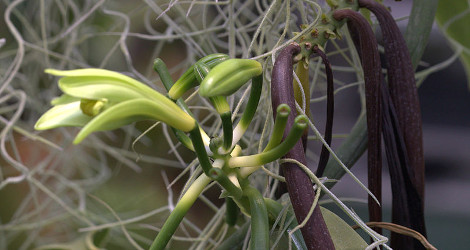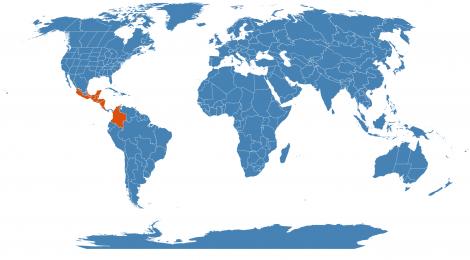Accession Data:
Vanilla planifolia Jacks. ex Andrews
- Common Name: Vanilla Orchid
- Family: Orchidaceae Juss.
- Description: [Syn. Vanilla fragrans]
This leafy climbing orchid is from hot, wet tropical America. The flowers are hand pollinated. Propagated generally by cutting.
The vanilla flower is self-fertile, but incapable of self-pollination without the aid of an outside agency to either transfer the pollen from the anther to the stigma or to lift the flap or rostellum then press the anther against the stigma. The only time this can be accomplished is during the morning of the one day the flower is open. Unless pollination occurs, the flower drops from the vine the next day.
- Uses: The vanilla orchid is grown for its seed pods that are harvested and go through an extensive drying and curing process to create commercial vanilla. Without this drying and curing the green seed pods do not contain a potent vanilla flavor. The drying process creates vanillin crystals and turns the pods from green to black.
In traditional Mexican medicine Vanilla was used to treat hysteria, fevers, impotence, rheumatism, and to increase the energy of muscular systems.1
- Culture: Keep plant in intermediate to warm temperatures in shade. Plant is grown in shade and require a lots of space for climbing. Plant can be mounted or grown in bark. Plant prefers dryouts between waterings. 4
- USDA Zone: 10a-11
Accession Data:
- Accession # 201100222
- Source: Lisa Palmer - Dartmouth College
- Accession Date: 07-06-2011
- Bench: 3228 - ORCH: NE Corner - Vanilla
- Currently: active - healthy
- Qty: 1 confirmed on 04-14-2025
Classification:
- Division: Magnoliophyta
- Class: Liliopsida
- SubClass: monocots
- Order: Asparagales
- SubOrder:
- Family: Orchidaceae
- SubFamily: Vanilloideae
- Tribe: Vanilleae
- SubTribe:
Flowering Data:
This accession has been observed in bloom on:| Year | Jan | Feb | Mar | Apr | May | Jun | Jul | Aug | Sep | Oct | Nov | Dec | ||||||||||||||||||||||||||||||||||||||||
|---|---|---|---|---|---|---|---|---|---|---|---|---|---|---|---|---|---|---|---|---|---|---|---|---|---|---|---|---|---|---|---|---|---|---|---|---|---|---|---|---|---|---|---|---|---|---|---|---|---|---|---|---|
| 2025 | ||||||||||||||||||||||||||||||||||||||||||||||||||||
| 2024 | ||||||||||||||||||||||||||||||||||||||||||||||||||||
| 2023 | ||||||||||||||||||||||||||||||||||||||||||||||||||||
| 2022 | ||||||||||||||||||||||||||||||||||||||||||||||||||||
| 2021 | ||||||||||||||||||||||||||||||||||||||||||||||||||||
| 2020 | ||||||||||||||||||||||||||||||||||||||||||||||||||||
| 2019 | ||||||||||||||||||||||||||||||||||||||||||||||||||||
| 2018 | ||||||||||||||||||||||||||||||||||||||||||||||||||||
| 2017 | ||||||||||||||||||||||||||||||||||||||||||||||||||||
References (internal):
- Spice Plants
- Plants with Extrafloral Nectaries
- Pollination Syndrome Scavenger Hunt
- Currently Featured Orchids
- EEB Greenhouse Holdings native to: Mexico Gulf / Mexico Southwest / Mexico Southeast / Belize / Costa Rica / El Salvador / Guatemala / Honduras / Nicaragua / Colombia /
References (external):
- Medicinal orchids and their uses: Tissue culture a potential alternative for conservation. Bijaya Pant. African Journal of Plant Science. Vol. 7(10), pp. 448-467, October 2013.
- The Plant List (2013). Version 1.1. Accessed 26 February 2015.
- WCSP (2015). World Checklist of Selected Plant Families. Facilitated by the Royal Botanic Gardens, Kew. Accessed 26 February 2015.
- Vanilla planifolia at Orchids Wiki. Accessed 23 May 2015.
- Image #00 (cropped) & #01 (original) by Averater (Own work) [GFDL or CC BY 3.0], via Wikimedia Commons. Last accessed on Thursday, October 26, 2017.
data regenerated on Tue, 15 Jul 2025 13:13:40 -0400 [bcm v4.0]
Images:

Additional images for this accession:
Click on thumbnails to enlargeCurrent Accessions in the Orchidaceae
Subfamily Cypripedioideae
Tribe Cypripedieae
- Paphiopedilinae: Paphiopedilum argus


- Paphiopedilinae: Paphiopedilum delenatii


- Paphiopedilinae: Paphiopedilum delenatii


- Paphiopedilinae: Paphiopedilum Delrosi


- Paphiopedilinae: Paphiopedilum Harrisianum
- Paphiopedilinae: Paphiopedilum haynaldianum


- Paphiopedilinae: Paphiopedilum mastersianum


- Paphiopedilinae: Paphiopedilum niveum


Subfamily Cypripedioideae
Tribe Phragmipedieae
- Phragmipediinae: Phragmipedium besseae


- Phragmipediinae: Phragmipedium Calurum
- Phragmipediinae: Phragmipedium Lemoinierianum

- Phragmipediinae: Phragmipedium Dominianum
- Phragmipediinae: Phragmipedium Demetria
- Phragmipediinae: Phragmipedium Schroederae

- Phragmipediinae: Phragmipedium longifolium


Subfamily Epidendroideae
Tribe Arethuseae
- Bletiinae: Bletilla striata


- Chysinae: Chysis bractescens


- Sobraliinae: Sobralia decora


- Sobraliinae: Sobralia decora x leucantha


Subfamily Epidendroideae
Tribe Coelogyneae
- Coelogyninae: Coelogyne asperata

- Coelogyninae: Coelogyne flaccida

- Coelogyninae: Coelogyne lawrenceana

- Coelogyninae: Coelogyne mayeriana


- Coelogyninae: Coelogyne ovalis

- Coelogyninae: Coelogyne rochussenii

- Coelogyninae: Coelogyne speciosa


- Coelogyninae: Coelogyne tomentosa

- Coelogyninae: Coelogyne usitana

- Coelogyninae: Dendrochilum cobbianum


- Coelogyninae: Dendrochilum magnum


- Coelogyninae: Dendrochilum sp.
- Coelogyninae: Dendrochilum wenzelii


- Coelogyninae: Dendrochilum yuccifolium

- Coelogyninae: Pholidota imbricata

- Thuniinae: Thunia alba

Subfamily Epidendroideae
Tribe Collabieae
Subfamily Epidendroideae
Tribe Cymbidieae
- Catasetinae: Catasetum fimbriatum var. morrenianum


- Catasetinae: Catasetum hybrid
- Catasetinae: Catasetum hybrid
- Catasetinae: Catasetum hybrid
- Catasetinae: Catasetum pileatum


- Cymbidiinae: Cymbidium aloifolium

- Cymbidiinae: Cymbidium dayanum 'Bolin'

- Cymbidiinae: Cymbidium finlaysonianum

- Cymbidiinae: Cymbidium sp.
- Eulophiinae: Eulophia andamanensis


- Eulophiinae: Eulophia guineensis
- Eulophiinae: Eulophia petersii


- Maxillariinae: Bifrenaria inodora


- Maxillariinae: Brasiliorchis schunkeana

- Maxillariinae: Maxillaria callichroma

- Maxillariinae: Maxillaria elatior
- Maxillariinae: Maxillaria houtteana

- Maxillariinae: Maxillaria pachyphylla

- Maxillariinae: Maxillaria sanguinea

- Maxillariinae: Prominaea stapelioides x guttata
- Maxillariinae: Maxillaria tenuifolia

- Maxillariinae: Maxillaria variabilis


- Maxillariinae: Mormolyca hedwigiae


- Maxillariinae: Mormolyca ringens


- Maxillariinae: Mormolyca rufescens


- Maxillariinae: Ornithidium sophronitis

- Maxillariinae: Trigonidium egertonianum


- Oncidiinae: Brassia jipijapensis

- Oncidiinae: Brassia maculata majus


- Oncidiinae: Brassia verrucosa

- Oncidiinae: Lockhartia lunifera


- Oncidiinae: Lockhartia oerstedii

- Oncidiinae: Lockhartia oerstedii

- Oncidiinae: Miltonia clowesii


- Oncidiinae: Miltonia flavescens


- Oncidiinae: Oncidium altissimum


- Oncidiinae: Oncidium hybrid
- Oncidiinae: Oncidium hybrid
- Oncidiinae: Oncidium maculatum


- Oncidiinae: Oncidium sphacelatum


- Oncidiinae: Oncidium tigrinum


- Oncidiinae: Oncidium unidentified
- Stanhopeinae: Gongora cassidea


- Stanhopeinae: Gongora histrionica

- Stanhopeinae: Gongora quinquenervis var uncinata

- Stanhopeinae: Gongora rufescens


- Stanhopeinae: Gongora scaphephorus


- Stanhopeinae: Stanhopea assidensis (tigrina x wardii)
- Stanhopeinae: Stanhopea costaricensis


- Stanhopeinae: Stanhopea ecornuta


- Stanhopeinae: Stanhopea grandiflora

- Stanhopeinae: Stanhopea graveolens


- Stanhopeinae: Stanhopea intermedia

- Stanhopeinae: Stanhopea jenischiana

- Stanhopeinae: Stanhopea lietzei

- Stanhopeinae: Stanhopea oculata


- Stanhopeinae: Stanhopea platyceras

- Stanhopeinae: Stanhopea tigrina

- Stanhopeinae: Stanhopea tigrina var. nigroviolacea

- Stanhopeinae: Stanhopea tigrina x wardii
- Stanhopeinae: Stanhopea wardii


- Zygopetalinae: Pescatoria wallisii

- Zygopetalinae: Zygopetalum maculatum


Subfamily Epidendroideae
Tribe Dendrobieae
- Bulbophyllinae: Bulbophyllum affine

- Bulbophyllinae: Bulbophyllum affine

- Bulbophyllinae: Bulbophyllum annamense

- Bulbophyllinae: Bulbophyllum careyanum


- Bulbophyllinae: Bulbophyllum cheiri

- Bulbophyllinae: Bulbophyllum corolliferum

- Bulbophyllinae: Bulbophyllum echinolabium


- Bulbophyllinae: Bulbophyllum elegantulum

- Bulbophyllinae: Bulbophyllum falcatum


- Bulbophyllinae: Bulbophyllum flammuliferum

- Bulbophyllinae: Bulbophyllum gibbosum


- Bulbophyllinae: Bulbophyllum gibbosum


- Bulbophyllinae: Bulbophyllum grandiflorum

- Bulbophyllinae: Bulbophyllum hahlianum

- Bulbophyllinae: Bulbophyllum lasiochilum

- Bulbophyllinae: Bulbophyllum lepidum


- Bulbophyllinae: Bulbophyllum lepidum


- Bulbophyllinae: Bulbophyllum lepidum


- Bulbophyllinae: Bulbophyllum lilacinum


- Bulbophyllinae: Bulbophyllum lobbii


- Bulbophyllinae: Bulbophyllum longiflorum

- Bulbophyllinae: Bulbophyllum longissimum

- Bulbophyllinae: Bulbophyllum morotaiense

- Bulbophyllinae: Bulbophyllum purpureorhachis

- Bulbophyllinae: Bulbophyllum roxburghii

- Bulbophyllinae: Bulbophyllum roxburghii

- Bulbophyllinae: Bulbophyllum tremulum

- Bulbophyllinae: Bulbophyllum vaginatum


- Dendrobiinae: Dendrobium anceps

- Dendrobiinae: Dendrobium anosmum


- Dendrobiinae: Dendrobium aphyllum


- Dendrobiinae: Dendrobium bifalce

- Dendrobiinae: Dendrobium bigibbum

- Dendrobiinae: Dendrobium brunneum

- Dendrobiinae: Dendrobium chrysotropis

- Dendrobiinae: Dendrobium x delicatum


- Dendrobiinae: Dendrobium farmeri


- Dendrobiinae: Dendrobium hymenanthum


- Dendrobiinae: Dendrobium jenkinsii

- Dendrobiinae: Dendrobium kingianum


- Dendrobiinae: Dendrobium lindleyi


- Dendrobiinae: Dendrobium lindleyi


- Dendrobiinae: Dendrobium moniliforme

- Dendrobiinae: Dendrobium nakaharae


- Dendrobiinae: Dendrobium plicatile


- Dendrobiinae: Dendrobium rigidum


- Dendrobiinae: Dendrobium speciosum var. hillii

- Dendrobiinae: Dendrobium speciosum var. pedunculatum

- Dendrobiinae: Dendrobium wassellii

Subfamily Epidendroideae
Tribe Epidendreae
- Glomerinae: Agrostophyllum planicaule

- Laeliinae: Barkeria melanocaulon


- Laeliinae: Brassavola cucullata

- Laeliinae: Brassavola nodosa


- Laeliinae: Brassocattleya hybrid
- Laeliinae: Cattleya luteola


- Laeliinae: Cattleya mossiae f. coerulea


- Laeliinae: Caularthron bicornutum


- Laeliinae: Dinema polybulbon

- Laeliinae: Encyclia unidentified

- Laeliinae: Epidendrum 'Max Valley'
- Laeliinae: Epidendrum oerstedii

- Laeliinae: Epidendrum radicans


- Laeliinae: Epidendrum rigidum


- Laeliinae: Epidendrum schlecterianum

- Laeliinae: Guarianthe bowringiana


- Laeliinae: Isabelia pulchella


- Laeliinae: Isochilus carnosiflorus

- Laeliinae: Laelia rubescens

- Laeliinae: Laelia tenebrosa


- Laeliinae: Myrmecophila christinae



- Laeliinae: Myrmecophila tibicinis


- Laeliinae: Scaphyglottis confusa

- Laeliinae: Scaphyglottis longicaulis

- Pleurothallidinae: Acianthera casapensis


- Pleurothallidinae: Anathallis linearifolia 'D&M'

- Pleurothallidinae: Dracula pusilla

- Pleurothallidinae: Masdevallia hybrid

- Pleurothallidinae: Masdevallia infracta


- Pleurothallidinae: Myoxanthus affinis


- Pleurothallidinae: Octomeria unidentified

- Pleurothallidinae: Pleurothallis longipedicellata

- Pleurothallidinae: Pleurothallis nuda

- Pleurothallidinae: Pleurothallis pedunculata

- Pleurothallidinae: Pleurothallis prolaticollaris

- Pleurothallidinae: Pleurothallis titan

- Pleurothallidinae: Pleurothallis truncata

- Pleurothallidinae: Pleurothallis unidentified
- Pleurothallidinae: Pleurothallis unidentified
- Pleurothallidinae: Restrepiella ophiocephala

- Pleurothallidinae: Specklinia brighamii


- Pleurothallidinae: Specklinia grobyi

- Pleurothallidinae: Specklinia tribuloides


- Pleurothallidinae: Stelis argentata

- Pleurothallidinae: Stelis argentata

- Pleurothallidinae: Stelis immersa

- Pleurothallidinae: Stelis megachlamys

- Pleurothallidinae: Stelis quadrifida

- Pleurothallidinae: Trichosalpinx chamaelepanthes

- Pleurothallidinae: Zootrophion hirtzii

Subfamily Epidendroideae
Tribe Malaxideae
Subfamily Epidendroideae
Tribe Podochileae
- Eriinae: Ceratostylis retisquama


- Eriinae: Eria carinata

- Eriinae: Campanulorchis globifera

- Eriinae: Eria javanica


- Eriinae: Mediocalcar decoratum



- Eriinae: Pinalia bractescens

- Eriinae: Pinalia copelandii


- Eriinae: Trichotosia velutina


Subfamily Epidendroideae
Tribe Vandeae
- Aerangidinae: Diaphananthe pellucida


- Aerangidinae: Microterangis hariotiana

- Aeridinae: Cleisocentron gokusingii

- Aeridinae: Phalaenopsis lueddemanniana


- Aeridinae: Robiquetia cerina

- Aeridinae: Sarcochilus hartmannii

- Aeridinae: Tuberolabium kotoense


- Aeridinae: Rhynchorides Thai Noi
- Aeridinae: Vanda tricolor var. suavis

- Angraecinae: Angraecum distichum


- Angraecinae: Angraecum sesquipedale


- Angraecinae: Jumellea arachnantha


- Polystachyinae: Neobenthamia gracilis


Subfamily Orchidoideae
Tribe Cranchideae
- Cranchidinae: Cladobium graminifolium

Subfamily Orchidoideae
Tribe Cranichideae
- Goodyerinae: Goodyera pubescens
- Goodyerinae: Ludisia discolor


- Prescottiinae: Prescottia plantaginifolia

Subfamily Orchidoideae
Tribe Diseae
- Satyriinae: Cynorkis calanthoides

- Satyriinae: Satyrium membranaceum

Subfamily Orchidoideae
Tribe Orchideae
- Orchidinae: Habenaria medusa


Subfamily Vanilloideae
Tribe Vanilleae
- Vanilla phalaenopsis

- Vanilla planifolia


- Vanilla planifolia variegata
- Vanilla pompona


- Vanilla roscheri

 = indicates flowering in past 14 days
= indicates flowering in past 14 days
 = images available for this accession
= images available for this accession
 = map available for this accession
= map available for this accession
 = accession added within past 90 days
= accession added within past 90 days

